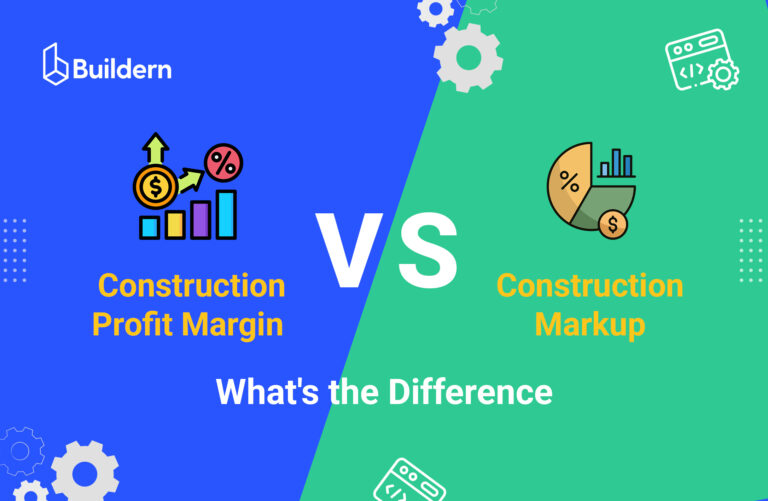Buildertrend vs. Procore: Which Is the Best Pick in 2025?
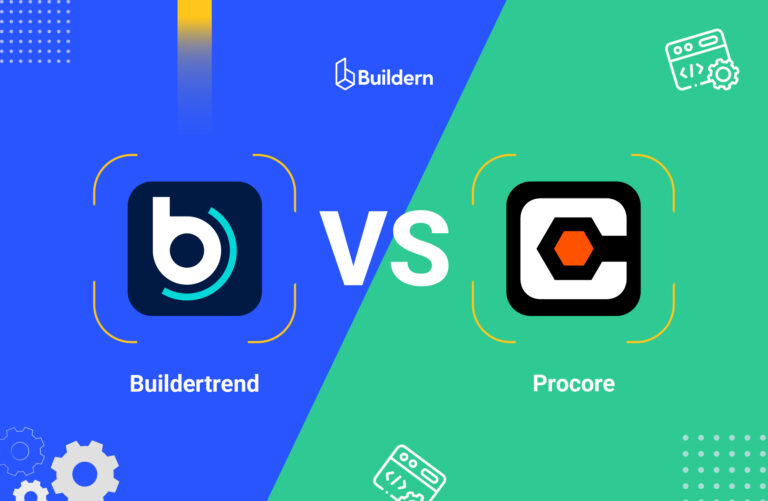
Buildertrend vs. Procore: Are you still trying to find construction project management software that actually works for your team?
If you’re a growing home builder or a large general contractor, you’ve probably come across these two names over and over again. Both are well-known platforms promising to simplify estimating, scheduling, collaboration, and financial control.
But the reality?
Buildertrend often feels intuitive until it starts to slow you down. In the same way, Procore covers almost everything, but only if you’re willing to pay for it, set it up, and train your entire company.
If you’ve been comparing Buildertrend and Procore, unsure which one can really support your day-to-day operations without added friction or unnecessary costs, this guide is for you. We’ll take a close look at both tools feature by feature, so you can see where they shine, where they fall short, and why many builders are now switching to a third option: Buildern.

Table of Contents
- Buildertrend vs. Procore: A Quick Overview
- Buildertrend vs. Procore: Estimating & Preconstruction Tools
- Buildertrend vs. Procore: Project Management & Field Collaboration
- Buildertrend vs. Procore: Financial Tools & Construction Accounting
- Pricing Transparency and Cost Considerations
- Usability, Scalability, and Support
- Buildertrend vs. Procore vs. Buildern: Why More Builders Are Making the Switch
- Final Thoughts
Buildertrend vs. Procore: A Quick Overview
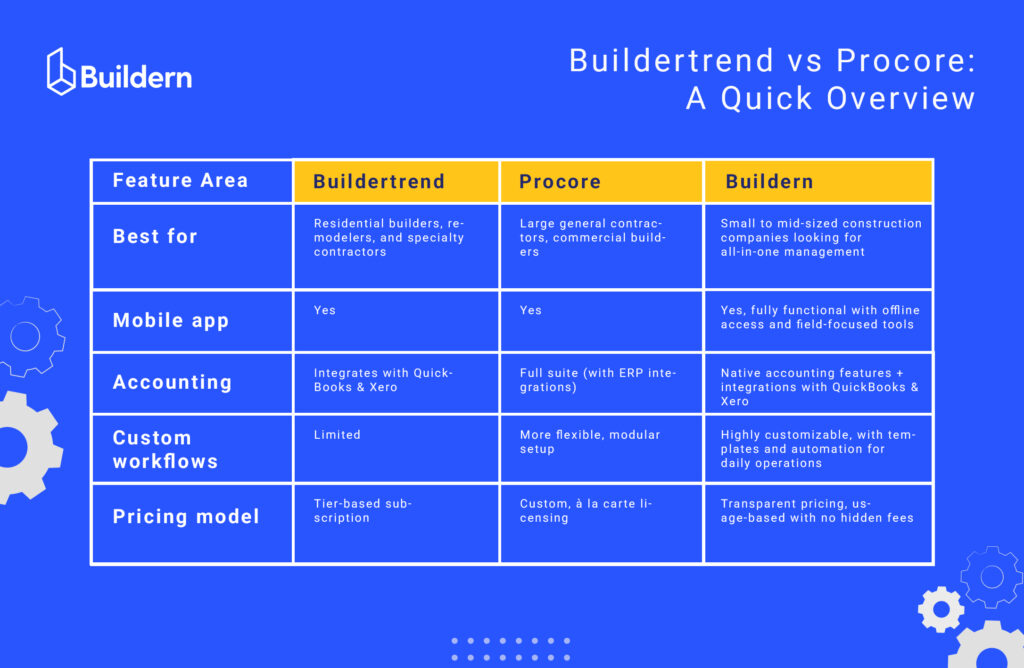
Buildertrend is cloud-based construction management software designed to support homebuilders, remodelers, and specialty contractors. Its tools and features simplify complex construction workflows and keep projects running toward timely completion. Their mobile application and a wide range of integrations help builders stay aligned, whether they’re in the office or on-site.
But is it as comprehensive as it sounds? Let’s take a closer look at some of its core features.
Buildertrend vs. Procore: Estimating & Preconstruction Tools
🔧 Buildertrend in Estimating: Good for Templates, Limited for Complexity
Buildertrend’s estimating tools are built for speed and repetition, ideal for builders working on similar residential projects. The platform simplifies early-stage budgeting and offers:
- Real-time job costing that tracks actuals against the original estimate
- Prebuilt templates for faster estimate creation
- Proposal generation directly linked to the estimate sheet
These features work well for builders with repeatable project scopes, but there are notable limitations when complexity enters the equation. Buildertrend’s estimating module lacks:
- Custom line item structures or grouped categories (e.g., by phase or cost type)
- Conditional pricing logic based on scope changes
- Advanced markup rules or automated fee structures
- Dynamic measurement tools that update quantities and pricing
For high-end custom homes, commercial work, or remodels with shifting requirements, the rigidity becomes a blocker.
🔧 Procore: Powerful, but Fragmented without Full Licensing
Procore’s preconstruction capabilities are stronger, especially when it comes to digital takeoffs and bid management, but only if you’ve licensed its Preconstruction suite. It includes:
- Cloud-based takeoff tools that integrate with plans and drawings
- Estimating modules that flow directly into bid management
- Side-by-side bid comparisons with automated subcontract conversion
These tools support large-scale workflows where speed, accuracy, and coordination between teams are critical. However, these are downsides:
- Estimating and takeoff features are not included by default; they must be purchased separately
- Subcontractor management, bid leveling, and takeoff often require training and onboarding
- The platform’s scale can be overwhelming for smaller or mid-sized teams.
Procore is well-suited for enterprise-level companies that can afford a full-stack implementation, but it may not make sense for teams that just need preconstruction tools without the extra overhead.
💡 Buildertrend vs. Procore? Estimating Software Solution That Adapts to Every Project
Buildern takes a more holistic and adaptable approach. Instead of treating estimating as a siloed task, Buildern integrates it into the full project lifecycle from takeoff to billing. Its estimating tools are intentionally flexible, allowing teams to:
- Build estimates from digital takeoffs or start fresh using drag-and-drop cost items
- Automatically calculate overheads, supervision fees, contingencies, and markups
- Group costs by project phase (e.g., site prep, framing, finishes) or type (labor, materials, subcontractors)
- Apply dynamic pricing, location-specific tax rates, and vendor-specific material costs
- Generate proposals, POs, client selections, and invoices directly from the estimate
👉 Key Differentiator: Estimating That Scales With Your Project
Most construction platforms treat estimating as a starting point. Buildern treats it as the operational core. It connects preconstruction with execution, so teams don’t lose time, context, or accuracy as a project moves forward.
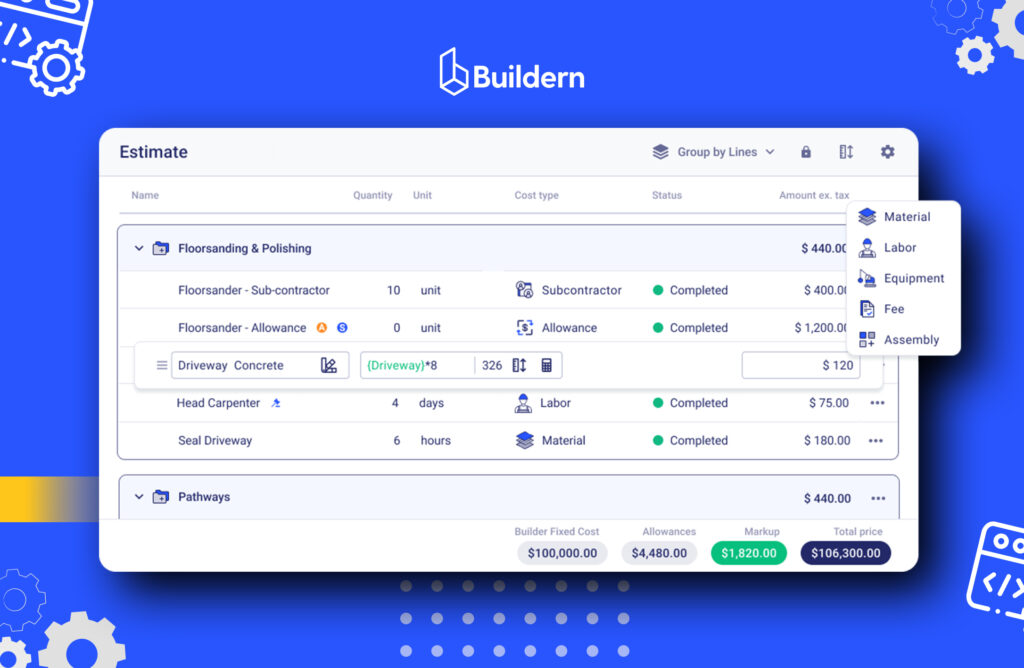
Buildertrend vs. Procore: Project Management & Field Collaboration
📋 Buildertrend: Familiar Interface, but Basic Controls
Buildertrend provides the essentials for project tracking and basic collaboration. The UI is approachable, making it easy for small teams to get started. Common tools include:
- Gantt chart scheduling for visualizing project timelines
- Daily logs with weather tracking to document job site activity
- To-do lists and reminders for managing team responsibilities
- Client communication portal for sharing updates and approvals
These tools work well in early project phases and for smaller residential builders. But as project complexity grows, coordination becomes harder. Buildertrend doesn’t offer robust version control, so updated files, revised schedules, or duplicated tasks can lead to misalignment between the field and the office. There’s also no built-in system for issue escalation, RFIs, or formal document workflows, leaving gaps in accountability.
📋 Procore: Complete Project Oversight with a Learning Curve
Procore is designed for enterprise-level coordination and offers a broad set of project management tools. It covers both field execution and documentation, including:
- Drawing and spec management with automatic version syncing
- RFIs, submittals, and punch list workflows built into the project timeline
- Real-time sync between field teams and office dashboards
- Customizable safety inspections, site logs, and QA/QC checklists
These tools support large crews and compliance-heavy projects. However, they come with complexity. Setting up workflows, assigning permissions, and managing multiple modules requires onboarding. Many teams need dedicated admin roles just to manage Procore usage. While it excels in documentation, day-to-day usability for subcontractors or smaller crews can be a challenge.
💡 Buildern: Clean, Clear, and Connected Solution
Buildern focuses on keeping teams aligned without slowing them down. It covers essential project management tasks while staying intuitive enough to be used on the go. Features include:
- Full project schedules, accessible on desktop and mobile
- Daily logs with filed updates, photos, and weather notes
- To-Do lists that can be assigned, commented on, and tracked in real time
- In-app messaging and project-specific chats for centralized communication
- Activity feeds that show a full history of project actions, by user and timestamp
- Progress photos and video uploads that keep office teams in the loop
There’s no need to install multiple apps or teach new workflows to subcontractors; everything is in one place, with a clean UI that mirrors how real teams work. Buildern connects the dots between job site execution and office oversight without adding unnecessary layers.
👉 Key Differentiator: Field Collaboration Without Friction
Most tools force teams to choose between usability and control. Buildern offers both. It supports real-time collaboration without the clutter or technical barriers found in larger systems.

Buildertrend vs. Procore: Financial Tools & Construction Accounting
💰 Buildertrend: Basic Budgeting and Billing
Buildertrend offers a user-friendly approach to construction finance, tailored mostly for small to mid-sized residential builders. Core features include:
- Budget tracking with links to active estimates and change orders
- Client invoicing with customizable formats
- Change Order management that connects to project documentation
- QuickBooks and Xero integrations for accounting sync
While it covers the basics, Buildertrend’s financial tools aren’t designed for complex workflows. There’s limited support for forecasting, multi-project oversight, or compliance-heavy billing structures like AIA formats. For teams managing several concurrent jobs or tracking costs across business units, this may quickly feel insufficient.
💰 Procore in Financial Management: Deep Oversight, Higher Complexity (vs. Buildertrend)
Procore is built for financial teams who need full control across large-scale construction projects. Its financial tools are robust, including:
- Commitment tracking for subcontracts, POs, and vendor agreements
- Budget forecasting with real-time updates across cost codes
- Work-in-progress (WIP) reporting to track earned revenue and predict cash flow
- Direct ERP integrations with platforms like Sage, Viewpoint, and CMiC
These features are powerful but require significant setup and maintenance. Cost code structures must be meticulously configured, and workflows often need custom rules. For smaller or mid-sized teams, this can become a drain, especially when combined with Procore’s separate licensing for financial tools.
💡 Buildern: Financial Solution without the Complexity
Buildern gives builders full visibility into their financials without the steep learning curve or staffing demands of larger systems. Designed to reflect how actual construction teams work, it offers:
- Budget vs. actuals tracking with automatic updates from the field
- Structured Change Order workflows with internal approvals and client sign-offs
- Cash flow projections based on project timelines and billing cycles
- Payment schedules tied to milestones, retainage, or completion percentages
- Integrated billing for both clients and subcontractors & vendors
- QuickBooks and Xero sync to avoid duplicate entry and manual errors
Every financial action in Buildern is linked to the source, whether it’s an estimate, a PO, or a Change Order, ensuring audit-ready documentation and clear accountability.
👉 Key Differentiator: Financial Tools Built for Builders, Not Accountants
Buildern doesn’t overload you with modules. Instead, it offers the essential financial controls construction teams actually need, aligned with how projects are run. From budgeting and billing to forecasting and payments, it keeps finance connected to field operations without requiring a finance department to manage the system.
Pricing Transparency and Cost Considerations
💵 Buildertrend: Tiered Plans, Hidden Trade-Offs
Buildertrend uses a three-tier pricing model. Each tier unlocks a new set of features, which makes budgeting more predictable, but also limits flexibility:
- Core tools like scheduling and estimating are available at lower tiers
- Higher-value features such as custom reporting, integrations, and client-facing tools are gated behind premium plans
- You pay per month, but some critical functions may force an upgrade even if you don’t need the rest of the bundle
The result? Teams often pay for tools they don’t use, just to unlock the ones they do.
💵 Procore: Modular, Expensive, and Complex
Procore follows a modular pricing structure. That means you:
- Purchase individual modules based on your workflow (e.g., preconstruction, financials, field productivity)
- Pay additional fees per user
- Often need implementation support just to get started
This model scales well for large enterprises with multiple departments. But for small to mid-sized contractors, it usually means overpaying for tools you can’t fully utilize or don’t need on every project.
💵 Buildern: Simple, Transparent, and Scalable
Buildern eliminates the guesswork from pricing. Instead of forcing contractors into rigid tiers or charging separately for every feature, Buildern offers a flat-rate model built around real construction workflows.
Every subscription includes:
- Full access to essential tools like estimating, scheduling, billing, and team collaboration, everything you need to run day-to-day operations efficiently
- No inflated costs for growing teams; add users, projects, and collaborators without triggering hidden fees or upgrades
- Unlimited projects, estimates, and file storage across all plans, so your platform scales as your workload grows, without surprise fees or storage caps
There are no user caps, no forced upgrades, and no sales calls just to get a quote. You know exactly what you’re paying for, and exactly what you’re getting.
Usability, Scalability, and Support
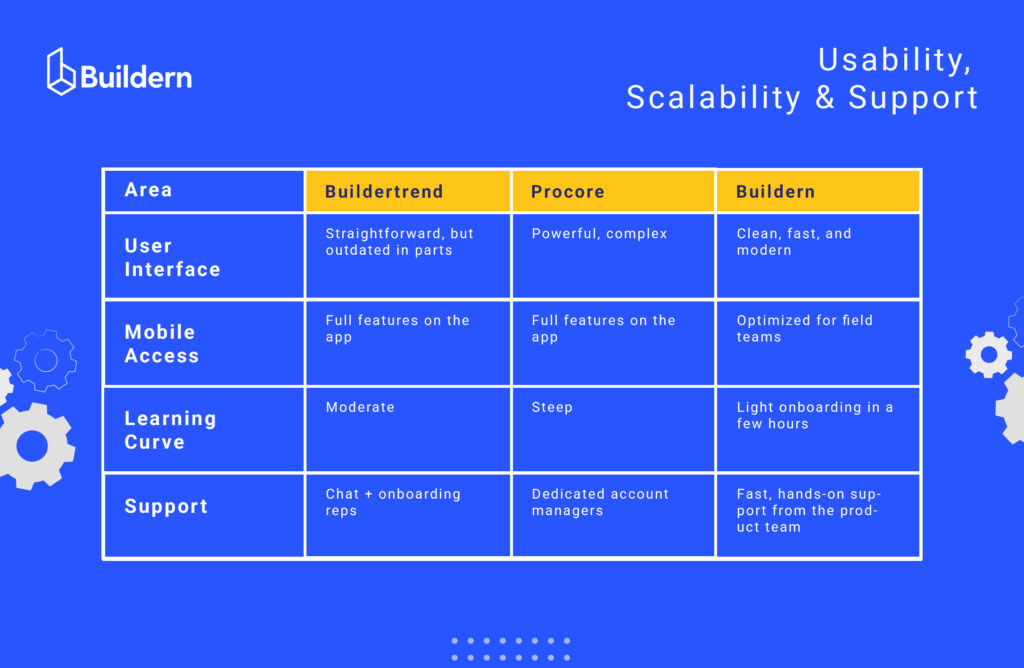
Buildertrend vs. Procore vs. Buildern: Why More Builders Are Making the Switch
If you’ve tried Buildertrend or Procore and found them either limiting or overly complex, you’re not alone. Buidern was created by construction professionals who saw firsthand how existing platforms fall short.
Instead of trying to be all things to all industries, Buildern focuses on what construction teams need most; It’s not about having the longest list of features but about having the right ones, implemented well. Backed by numerous positive reviews from real users, Buildern has proven to streamline construction workflows and improve team collaboration across the board:
- Estimating tools that grow with the project; adjust pricing, scope, and structure without starting over
- Real–time collaboration between field and office, with mobile-first access to schedules, documents, updates, etc.
- Streamlined financial controls that connect estimating, billing, and budget tracking in one place
- Transparent pricing; no hidden fees, no paywalls, no confusing tiers
- Responsive customer support, product walk-throughs, and weekly updates based on real user feedback
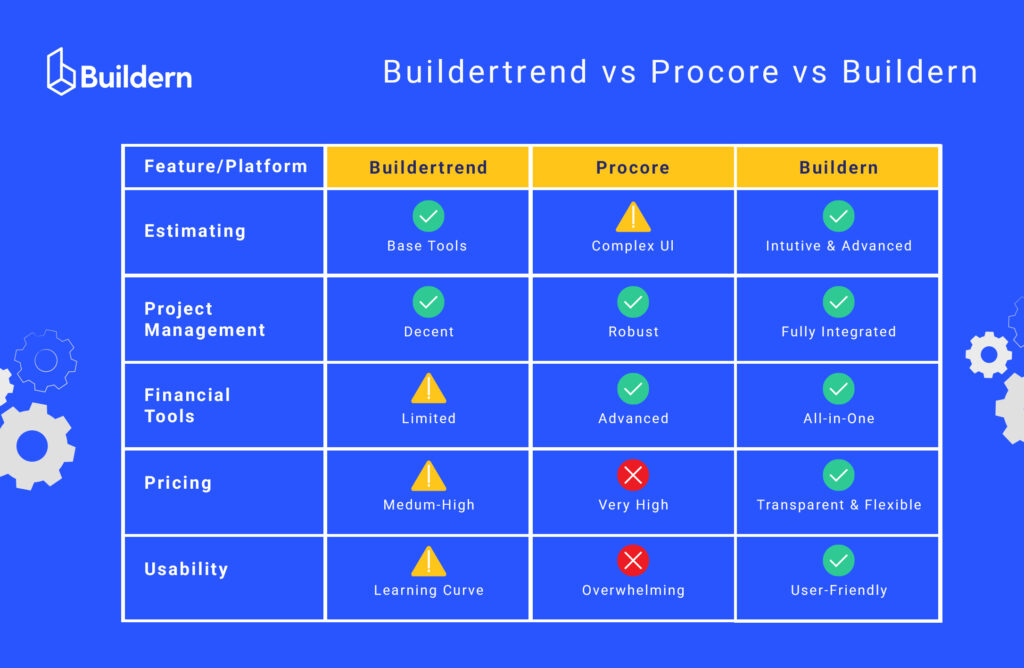
👉 Built for Builders. Backed by Builders.
Buildern isn’t just another construction tech company. It’s a platform shaped by actual jobsite experience, built to remove friction instead of creating more of it.
If your team is ready to move faster, communicate better, and gain financial clarity without adding complexity, Buildern is the platform to grow with.
Final Thoughts
Buildertrend is approachable and easy to use, but its limitations in customization and flexibility can slow down as projects grow in complexity.
Procre delivers an extensive suite of features, but its learning curve, cost, and implementation time often make it better suited for large enterprises.
Buildern offers a smarter alternative – powerful where it counts, intuitive where it matters!
It hits the balance, giving you the depth you need, with the speed and clarity your team expects.
Before choosing a platform, ask yourself:
Are you managing construction, or managing your software?
With Buildern, it’s finally about building again 🙂



